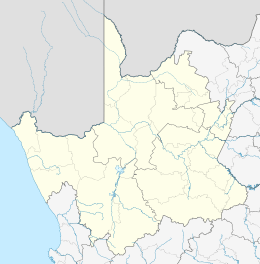Douglas, Northern Cape
| Douglas | |
|---|---|
|
Douglas suburbia | |
 Douglas  Douglas  Douglas
| |
| Coordinates: 29°03′S 23°46′E / 29.050°S 23.767°ECoordinates: 29°03′S 23°46′E / 29.050°S 23.767°E | |
| Country | South Africa |
| Province | Northern Cape |
| District | Pixley ka Seme |
| Municipality | Siyancuma |
| Established | 1867 |
| Area[1] | |
| • Total | 86.42 km2 (33.37 sq mi) |
| Elevation | 990 m (3,250 ft) |
| Population (2011)[1] | |
| • Total | 20,083 |
| • Density | 230/km2 (600/sq mi) |
| Racial makeup (2011)[1] | |
| • Black African | 32.1% |
| • Coloured | 58.3% |
| • Indian/Asian | 0.8% |
| • White | 8.0% |
| • Other | 0.9% |
| First languages (2011)[1] | |
| • Afrikaans | 93.1% |
| • Tswana | 2.3% |
| • English | 1.5% |
| • Other | 3.1% |
| Postal code (street) | 8730 |
| PO box | 8730 |
| Area code | 053 |
Douglas is a town situated near the confluence of the Orange and Vaal Rivers in the Northern Cape province of South Africa. On this fertile soil nestles the town of Douglas. The town itself is a green patchwork of dramatic contrast - space for the solitary and activity for the energetic. Douglas is divided in three sections or locations named Bongani, Breipaal and Douglas.
Location
Douglas lies about 100 km on the R357 road[2] Southwest of Kimberley, the famous city of diamonds.
History
The town was founded in 1848 as a mission station on the farm Backhouse by the Reverend Isaac Hughes. In 1867, a group of Europeans from Griquatown signed an agreement giving them the right to establish a town. The town was named after General Sir Robert Percy Douglas, Lieutenant Governor of the Cape Colony.
References
- 1 2 3 4 "Main Place Douglas". Census 2011.
- ↑ Travel distances
 |
Campbell | Kimberley |  | |
| Griekwastad | |
Plooysburg, Ritchie | ||
| ||||
| | ||||
| Prieska | Hopetown |

.svg.png)